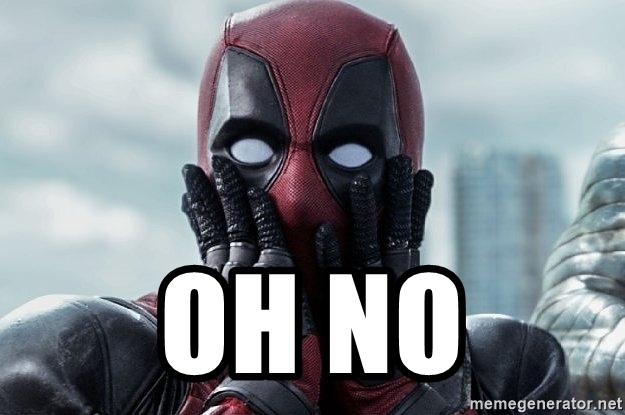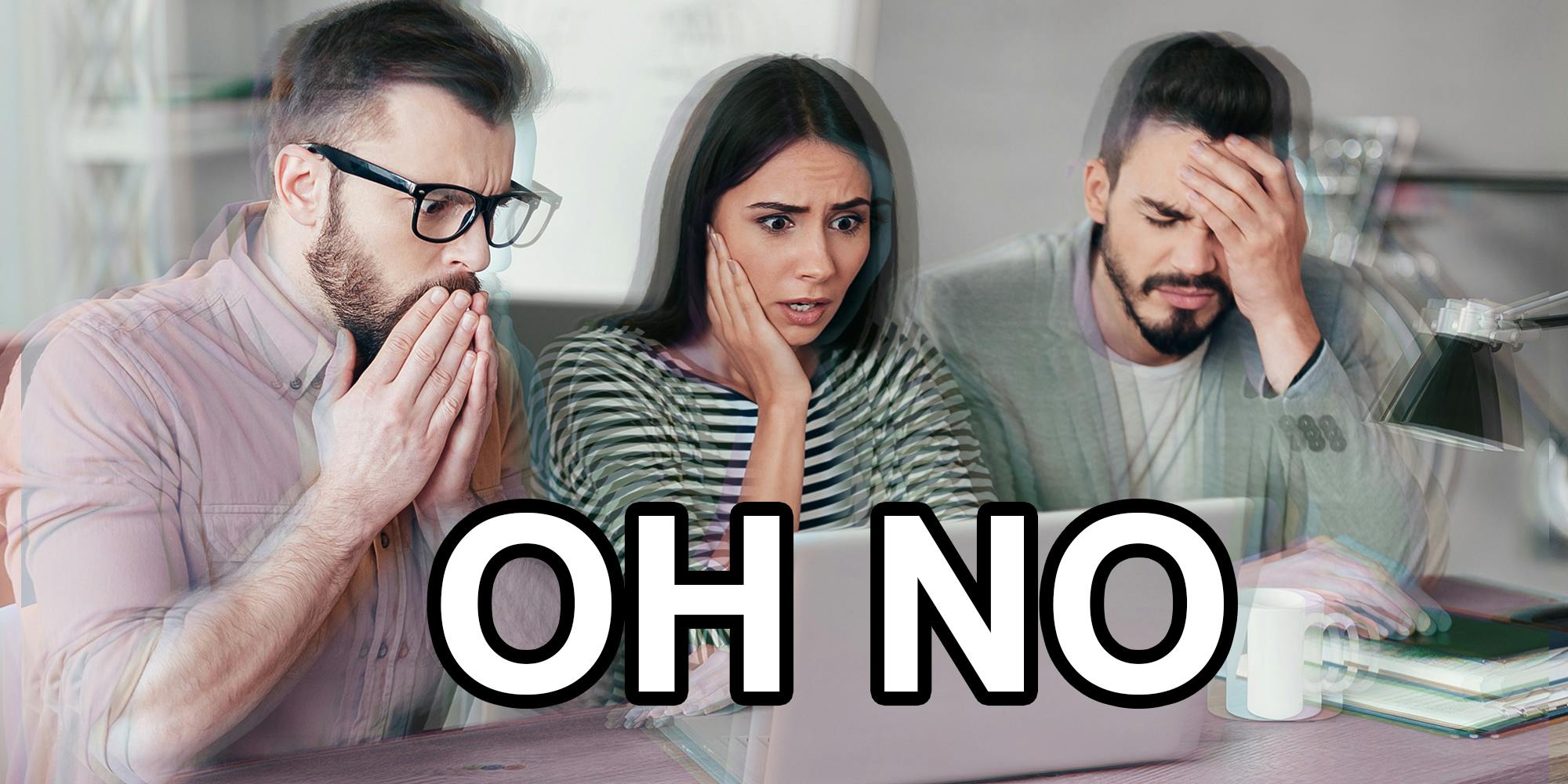The "Oh No Meme": Unpacking Its Viral Impact And Origins
In the vast and ever-evolving landscape of internet culture, certain phenomena transcend fleeting trends, embedding themselves deeply into our collective consciousness. One such pervasive element is the "Oh No Meme," a simple yet profoundly effective audio clip that has become synonymous with impending disaster, comical mishaps, and moments of utter realization. This ubiquitous sound, often paired with visual gags, has carved out a unique niche, serving as a universal shorthand for that stomach-dropping feeling when things go spectacularly wrong.
From amateur home videos capturing unexpected spills to professionally produced skits highlighting awkward social blunders, the "Oh No Meme" provides the perfect soundtrack to life's less-than-perfect moments. Its power lies in its immediate recognizability and the emotional resonance it evokes, instantly connecting viewers through a shared understanding of impending doom or comedic failure. But where did this iconic sound originate, and how did it achieve such widespread adoption across diverse digital platforms?
Table of Contents
- The Anatomy of an "Oh No" Moment
- Tracing the Sonic Roots: The Shangri-Las' "Remember (Walking in the Sand)"
- Why We Relate: The Universal Language of Misfortune
- The Meme's Evolution: From Vine to TikTok and Beyond
- Crafting Your Own "Oh No" Moment: Tips and Tools
- The Cultural Significance of the "Oh No Meme"
- Navigating the Meme Landscape: Where to Find and Share
- Conclusion: The Enduring Power of a Simple Sound
The Anatomy of an "Oh No" Moment
The essence of the "Oh No Meme" lies in its ability to perfectly encapsulate a moment of dawning realization that something undesirable is about to happen, or has just happened. It's that split second when a situation transitions from normal to catastrophic, from mundane to hilarious disaster. Consider the anecdote of a history teacher giving an online class, only for a window cleaner to literally spray water and soap into her living room through an open window. This is a quintessential "oh no" moment – unexpected, disruptive, and utterly out of the teacher's control, leading to an immediate, relatable sense of dismay. The meme typically features a video clip leading up to a comical or unfortunate event, often slowing down or freezing just as the peak of the incident occurs, with the distinctive "oh no, oh no, oh no no no no" vocal sample playing over the scene. Sometimes, a laugh track might be layered on top, though the core "oh no" vocal is the primary identifier. The anticipation built by the visual cue, combined with the audio, creates a powerful comedic effect, allowing viewers to vicariously experience the character's (or person's) predicament. This universal appeal is what has allowed the "Oh No Meme" to resonate across cultures and demographics, becoming a staple in online humor.Tracing the Sonic Roots: The Shangri-Las' "Remember (Walking in the Sand)"
One of the most common questions posed by those encountering the meme for the first time is, "Where does the oh no no no laughing track used in videos and memes originate from?" While some variations might include a generic laugh track, the iconic vocal sample that defines the "Oh No Meme" actually comes from a much older, and perhaps unexpected, source: a classic 1960s pop song.A Blast from the Past: The 1960s Hit
The unmistakable vocal refrain of "oh no, oh no, oh no no no no" is lifted directly from the 1964 hit song "Remember (Walking in the Sand)" by the American girl group The Shangri-Las. This doo-wop inspired track, known for its dramatic spoken-word passages and melancholic tone, tells a story of lost love. The specific segment that became the meme's signature is a powerful, almost wailing vocalization that perfectly conveys distress and regret. It’s a moment of emotional intensity in the song, which, when taken out of context and paired with modern-day mishaps, transforms into a comedic goldmine. The Shangri-Las were pioneers in the "teen tragedy" subgenre of pop music, often singing about heartbreak, rebellion, and dramatic events. "Remember (Walking in the Sand)" was one of their most successful singles, reaching number five on the Billboard Hot 100 chart. The song's enduring legacy is a testament not only to its musical quality but also to its distinctive vocal elements, one of which would, decades later, find an entirely new life in the digital age.From Doo-Wop to Digital Dominance
The journey of this specific vocal snippet from a 1960s pop song to a viral internet sensation is a fascinating example of how cultural artifacts are recontextualized and repurposed in the digital era. The transition wasn't immediate; it took decades for the sound to be discovered, isolated, and then adopted by online content creators. The Shangri-Las, in their time, could never have foreseen their dramatic vocalizations becoming the soundtrack to a cat falling off a counter or a person tripping over their own feet. This transformation highlights the democratizing nature of the internet, where obscure or forgotten cultural elements can be resurrected and given new meaning by a global audience. The "Oh No Meme" stands as a testament to the timeless power of certain sounds and expressions to convey universal human experiences, regardless of their original context.Why We Relate: The Universal Language of Misfortune
The enduring popularity of the "Oh No Meme" is deeply rooted in its psychological appeal. Humans are inherently drawn to narratives of misfortune, especially when they are harmlessly observed from a distance. There's a certain schadenfreude, a pleasure derived from another's misfortune, that plays a role. However, it's more than just that. The meme taps into a universal human experience: the moment of realization that something has gone wrong, or is about to. Everyone has had an "oh no" moment, whether it's dropping a freshly brewed cup of coffee, realizing you forgot an important deadline, or witnessing a clumsy accident. The meme provides a humorous lens through which to view these common predicaments. By adding the dramatic, almost operatic "oh no" vocal, it elevates mundane mishaps into cinematic moments of comedic tragedy. This shared understanding fosters a sense of community among viewers, as they collectively nod in recognition and amusement. It's a way of acknowledging the absurdities and imperfections of life, transforming potential frustration into laughter. This relatability is a key factor in the meme's ability to transcend cultural barriers and resonate with a global audience.The Meme's Evolution: From Vine to TikTok and Beyond
Like many internet phenomena, the "Oh No Meme" didn't explode overnight. Its journey to ubiquity involved a gradual adoption across various platforms, each contributing to its refinement and widespread recognition. Understanding its evolution helps to appreciate its current standing as a meme powerhouse.Early Adoptions and Viral Spikes
While pinpointing the exact first use of the "Oh No" sound in a meme context can be challenging, platforms like Vine, with their short, looping video format, likely played a significant role in its early popularization. The concise nature of Vine videos was perfect for quick, punchy comedic setups leading to an "oh no" payoff. As Vine faded, other platforms picked up the torch. YouTube compilations of "fails" and "epic fails" frequently incorporated the sound, solidifying its association with moments of accidental blunders. The true explosion of the "Oh No Meme" came with the rise of TikTok. TikTok's algorithm, emphasis on short-form video, and built-in audio library made it incredibly easy for users to discover and apply trending sounds to their content. The "Oh No" sound became a staple for creators showcasing everything from cooking disasters to pet antics, home renovation mishaps, and even unexpected plot twists in fictional narratives. Its versatility allowed it to adapt to countless scenarios, leading to exponential growth in its usage and recognition.The "Oh No Meme" in Modern Content Creation
Today, the "Oh No Meme" is not just for amateur creators. Brands, marketing agencies, and even news outlets have leveraged its power to create relatable and engaging content. Its immediate recognition ensures that viewers instantly grasp the intended comedic or dramatic tone. For example, a company might use the meme to highlight a common problem their product solves, presenting the "oh no" moment as the problem and their solution as the relief. The meme's adaptability also means it continues to evolve. While the core "oh no" sound remains, creators often pair it with new visual trends, different editing styles, or incorporate it into longer narrative arcs. This constant reinvention ensures its freshness and continued relevance in the fast-paced world of internet trends. The "Oh No Meme" has truly become a part of the digital lexicon, understood and appreciated by millions worldwide.Crafting Your Own "Oh No" Moment: Tips and Tools
For aspiring content creators looking to tap into the power of the "Oh No Meme," understanding its fundamental elements is key. The most effective "oh no" videos often follow a simple but potent formula:- The Setup: Begin with a seemingly normal situation or action. This builds anticipation and allows the viewer to connect with the scenario.
- The Inciting Incident: Introduce the element that will lead to the "oh no" moment. This could be a slip, a miscalculation, an unexpected external factor, or a dawning realization.
- The "Oh No" Transition: Just as the incident culminates or the realization hits, the video often slows down, freezes, or cuts to a dramatic angle. This is where the iconic "oh no, oh no, oh no no no no" audio clip is layered in.
- The Payoff (Optional): Sometimes, the video will show the full extent of the disaster for comedic effect, or it might cut away, leaving the viewer to imagine the outcome.
The Cultural Significance of the "Oh No Meme"
Beyond its comedic value, the "Oh No Meme" holds a subtle but significant place in contemporary internet culture. It serves as a form of collective coping mechanism, allowing individuals to laugh at the minor misfortunes that are an inevitable part of life. In a world often filled with stress and serious challenges, memes like "Oh No" offer a lighthearted escape, a moment of shared levity. It also represents the ongoing evolution of communication. Just as ancient cultures used fables and parables to convey moral lessons or shared experiences, modern digital communities use memes to express complex emotions, reactions, and narratives in a concise, universally understood format. The "Oh No Meme" is a prime example of this, distilling a complex feeling of dread or regret into a simple, instantly recognizable audio cue. Its pervasive nature underscores how deeply integrated internet culture has become into our daily lives, influencing how we perceive and react to the world around us.Navigating the Meme Landscape: Where to Find and Share
For those looking to explore the vast world of memes, including the "Oh No Meme," several online communities serve as invaluable resources. The official subreddit for the Know Your Meme website, with its 16k subscribers in the knowyourmeme community, is a definitive authority. Know Your Meme is an online encyclopedia dedicated to documenting and explaining viral phenomena, internet memes, and other online trends. It is mainly managed and used by regulars who meticulously research and archive meme origins, spread, and variations. If you want to understand the history and nuances of virtually any meme, Know Your Meme is the place to go. Beyond dedicated meme encyclopedias, general meme communities on platforms like Reddit are excellent for discovering new content and sharing your own. There are subreddits like "The biggest subreddit dedicated to providing you with the meme templates you're looking for," where users can post their templates or request one instead. These communities are vibrant hubs of creativity and collaboration, constantly generating new content and evolving existing trends. For discussions on specific niches, like the 78k subscribers in the octopathtraveler community, you'll find dedicated spaces for all discussion regarding Octopath Traveler, both discussion of the original game and champions, showcasing how memes often cross over into specific fan bases. Engaging with these communities not only provides entertainment but also offers insight into the dynamic nature of internet culture.Conclusion: The Enduring Power of a Simple Sound
The "Oh No Meme" stands as a testament to the unpredictable and often humorous ways in which cultural elements are repurposed and reimagined in the digital age. From its humble origins as a dramatic vocalization in a 1960s pop song by The Shangri-Las, it has transformed into a universal symbol of impending doom and comedic misfortune. Its enduring popularity is a clear indicator of its relatability and versatility, providing a perfect soundtrack to the myriad of "oh no" moments that pepper our daily lives. As internet culture continues to evolve, the "Oh No Meme" serves as a reminder of the power of a simple sound to convey complex emotions and connect people across the globe through shared laughter. It's a prime example of how digital creativity can breathe new life into old content, creating something entirely new and universally understood. So, the next time you witness a minor mishap or a grand blunder, listen closely – you might just hear the familiar refrain of the "Oh No Meme" playing in the background of your mind. What's your favorite "Oh No" moment you've witnessed or experienced? Share your stories in the comments below, and don't forget to share this article with fellow meme enthusiasts! Explore more of our articles to dive deeper into the fascinating world of internet phenomena.
Oh No Meme Face

50+ Funny Oh No Memes That Are Trending On TikTok Videos

Here's Some of the Best "Oh No" Memes